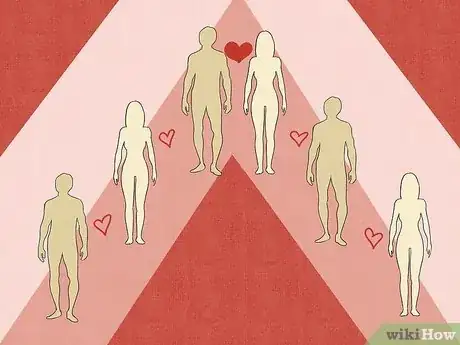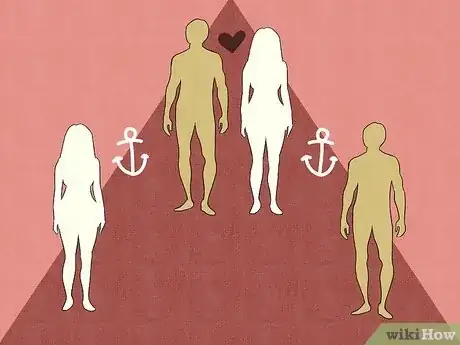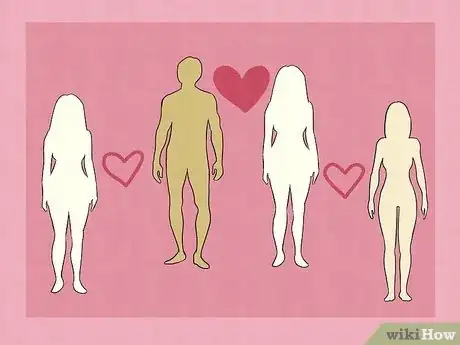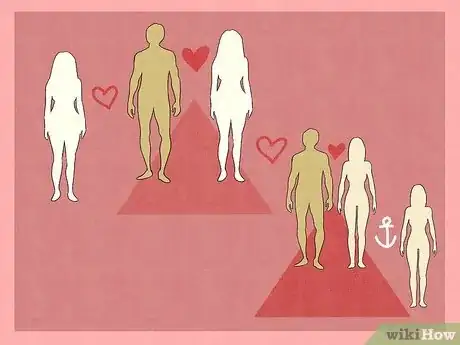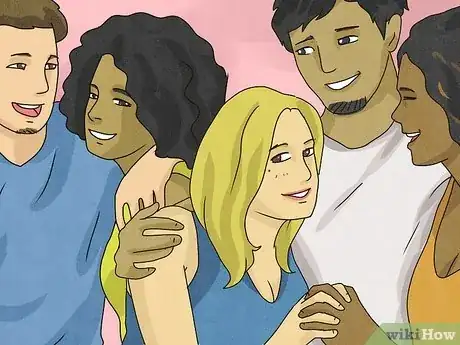This article was co-authored by wikiHow staff writer, Christopher M. Osborne, PhD. Christopher Osborne has been a wikiHow Content Creator since 2015. He is also a historian who holds a PhD from The University of Notre Dame and has taught at universities in and around Pittsburgh, PA. His scholarly publications and presentations focus on his research interests in early American history, but Chris also enjoys the challenges and rewards of writing wikiHow articles on a wide range of subjects.
There are 8 references cited in this article, which can be found at the bottom of the page.
This article has been viewed 3,614 times.
Learn more...
Have you been asked if you’re in a poly relationship, or if you’re interested in joining one, and been unsure how to respond? Or are you just curious about polyamory? If so, you’ve come to the right place. In this article, we’ve collected a mix of definitions and answers that’ll give you a better understanding of polyamory.
Steps
Defining Polyamory
-
Polyamory is a form of romantic relationship involving at least three partners. In other words, unlike monogamy, which includes two partners who mutually consent to a romantic relationship, a poly relationship includes three or more partners. Polyamory covers a lot of possible relationship types, which are open to be defined and redefined by those in them.[1] X Research source That said, communication and consent are the cornerstones of polyamory.[2] X Research source
- Partners must be free and able to communicate openly and honestly with each other, and to trust each other. Polyamory is not about “sleeping around” behind your partner’s back, at least not without their consent. Each partner must be absolutely free to consent (or not) to all aspects of the relationship that affect them.[3] X Trustworthy Source Greater Good Magazine Journal published by UC Berkeley's Greater Good Science Center, which uses scientific research to promote happier living Go to source
Poly Relationship Types
-
1Hierarchical polyamory. This setup usually begins with a “primary” relationship, typically a couple, that branches out into “secondary” relationships. The primary relationship sets the “rules” for the secondary relationships and each primary member may have “veto power” over adding or keeping secondary partners.[4] X Trustworthy Source PubMed Central Journal archive from the U.S. National Institutes of Health Go to source
- In some cases, the primary couple may live together, be married, and/or have children.
- The primary relationship usually has priority when it comes to spending time together.
-
2Anchor (nesting) partners. Like hierarchical polyamory, this relationship setup often begins with a primary couple that may cohabit or share finances. However, despite this “anchor” (or “nesting”) status, this relationship is not specifically given priority over other relationships within the group.[5] X Research source
- This is also known as non-hierarchical polyamory.
- While the aim here is to treat each relationship within the group with equal priority, it can be a challenge not to prioritize the anchor relationship.
-
3Triad (or “thruple”). As you might guess by the name, this is a poly relationship with three partners. It often, but not always, forms when a poly couple invites a third partner into the group. A triad can be hierarchical (with the original couple prioritized) or non-hierarchical (with three equal partners).[6] X Research source
- Females who join an existing couple to form a triad are sometimes called “unicorns” (because they’re hard to find), while males in the same situation are sometimes called “dragons” (probably just in keeping with the mythical creature theme).
-
4Vee (or “V”). This is a specific type of triad (or thruple) in which one “hinge” partner has separate relationships with two other partners, but those two other partners don’t have relationships with each other. Confused? Here’s an example:[7] X Research source
- Jan, Ben, and Ian are in a vee.
- Jan is the “hinge.” She is romantically involved with Ben and Ian.
- Ben and Ian are not romantically involved.
-
5Quad. This poly relationship involves four members, but the relationships among the four can take various forms. A classic quad, for example, includes two couples, each of which has one partner who crosses over to date a member of the other couple. A full quad, however, includes a greater romantic and/or sexual connection among all four members of the group.[8] X Research source
-
6Polyfidelity. In this situation, all partners in the current relationship agree that the group is now closed to new members. In other words, everyone in the triad, quad, or other poly relationship groups agrees not to seek out additional romantic or sexual partners outside the group.[9] X Research source
- Partners might agree to polyfidelity once “polysaturation” is achieved—that is, when they agree that there isn’t enough time or energy available to add new members.
-
7Relationship anarchy. The goal here is to remove the rules, barriers, and hierarchies found in other poly relationship structures. Each group member can (if they choose) connect romantically and/or sexually with other members without worrying about breaking the rules. Group members can typically also establish new relationships outside the current group, but open communication with the group about these relationships is still expected.[10] X Research source
- Critics of polyamory might point to relationship anarchy as proof that being poly is just about “sleeping around” without any rules. However, open communication and trust among partners is still central to this type of poly relationship.
-
8Solo polyamory. A person practicing solo polyamory typically lives alone—or at least not with any of their romantic/sexual partners—and maintains relationships with multiple partners without any type of hierarchy. Essentially, each person within the relationship group can “do their own thing,” so long as they stick to the core poly values of communication and consent.[11] X Research source
Poly Relationship Terminology
-
1Polycule. This term refers to the entire network of people connected to the poly group. This can include primary partners, secondary partners, and partners who don’t have direct relationships with each other, to name a few examples. It can potentially even include people who aren’t directly in the group, such as someone who lives with one of the poly group members but isn’t a member themself.[12] X Research source
-
2Kitchen table polyamory. In the ideal version of this setup, everyone in the polycule regularly meets together to communicate openly about questions, concerns, or other issues. So, in this case, the two partners of the “hinge” member of a vee—who don’t have a direct relationship with each other—are given an open forum to discuss what’s on their minds.[13] X Research source
- It’s nice to picture these meetings happening with everyone sitting around the kitchen table, but these days it’s common for them to occur virtually instead.
-
3Parallel polyamory. This is pretty much the opposite of kitchen table polyamory. Here, partners-of-partners (for instance, the non-hinge members of a vee) don’t directly communicate. Instead, they rely on the connecting partner (such as the hinge in the vee) to essentially work as a mediator to navigate and resolve questions and concerns.[14] X Research source
- Parallel polyamory is more common in polycules that have greater degrees of hierarchy among primary and secondary partners.
Do poly relationships work out?
-
1Polyamory can be just as successful and fulfilling as monogamy. Polyamory is a valid relationship style that can absolutely succeed.[15] X Trustworthy Source PubMed Central Journal archive from the U.S. National Institutes of Health Go to source Or, just like any other type of relationship, it can fail due to things like incompatibility, infidelity, or substance abuse. Poly relationships tend to work best when partners are open-minded and not prone to jealousy. Here are some quick pros and cons to consider:
- Poly relationships offer more practical support than monogamy because each partner doesn’t have to rely on just one other person. Similarly, they can be more sexually fulfilling.
- Poly relationships, however, can turn out to be too much work for some people or foster unexpected jealousy. Another challenge is the fact that most societies are structured around monogamy as the default relationship style.
-
2Poly relationships require honest and open communication. Communication is critical in a monogamous relationship, of course, but it may be even more essential when you’re in a polyamorous relationship. Each group member’s feelings, preferences, concerns, and questions must be addressed so that everyone can be heard, respected, and satisfied.[16] X Research source Key areas that must be talked about openly and frequently include:
- The rules, guidelines, and boundaries that do (or don’t) exist in the polycule.
- The amount and quality of time spent with different partners within the polycule.
- Issues like jealousy, possessiveness, and sexual preferences that inevitably crop up.
You Might Also Like

 Signs Your Ex Will Eventually Come Back
Signs Your Ex Will Eventually Come Back


 What Are the Bases in a Relationship? Defining the Baseball-Sex Metaphor
What Are the Bases in a Relationship? Defining the Baseball-Sex Metaphor
 The Top Emojis a Girl Will Use if She Likes You
The Top Emojis a Girl Will Use if She Likes You
 How to Tell if Your Girlfriend Is Horny: 12 Signs She's Turned On
How to Tell if Your Girlfriend Is Horny: 12 Signs She's Turned On
 What to Do When Your Girlfriend Is Mad at You (10+ Steps to Take)
What to Do When Your Girlfriend Is Mad at You (10+ Steps to Take)
 12+ Texts to Send Your Girlfriend After a Fight: Apologies & More
12+ Texts to Send Your Girlfriend After a Fight: Apologies & More
 How to Have Phone Sex with Your Girlfriend
How to Have Phone Sex with Your Girlfriend

 33 Sweet & Romantic Apology Messages for Your Love
33 Sweet & Romantic Apology Messages for Your Love
 12 Ways to Break a Narcissist's Heart
12 Ways to Break a Narcissist's Heart

References
- ↑ https://link.springer.com/article/10.1007/s10508-021-02002-y
- ↑ https://metro.co.uk/2017/06/28/what-is-polyamory-and-a-polyamorous-relationship-6741253/
- ↑ https://greatergood.berkeley.edu/article/item/what_you_can_learn_from_polyamory
- ↑ https://pubmed.ncbi.nlm.nih.gov/33956295/
- ↑ https://www.choosingtherapy.com/polyamory/
- ↑ https://www.choosingtherapy.com/polyamory/
- ↑ https://greatist.com/connect/polyamorous#terminology
- ↑ https://greatist.com/connect/polyamorous#terminology
- ↑ https://www.choosingtherapy.com/polyamory/
- ↑ https://www.choosingtherapy.com/polyamory/
- ↑ https://www.choosingtherapy.com/polyamory/
- ↑ https://greatist.com/connect/polyamorous#terminology
- ↑ https://www.choosingtherapy.com/polyamory/
- ↑ https://www.choosingtherapy.com/polyamory/
- ↑ https://pubmed.ncbi.nlm.nih.gov/34105057/
- ↑ https://www.morethantwo.com/polycatintro.html
About This Article


